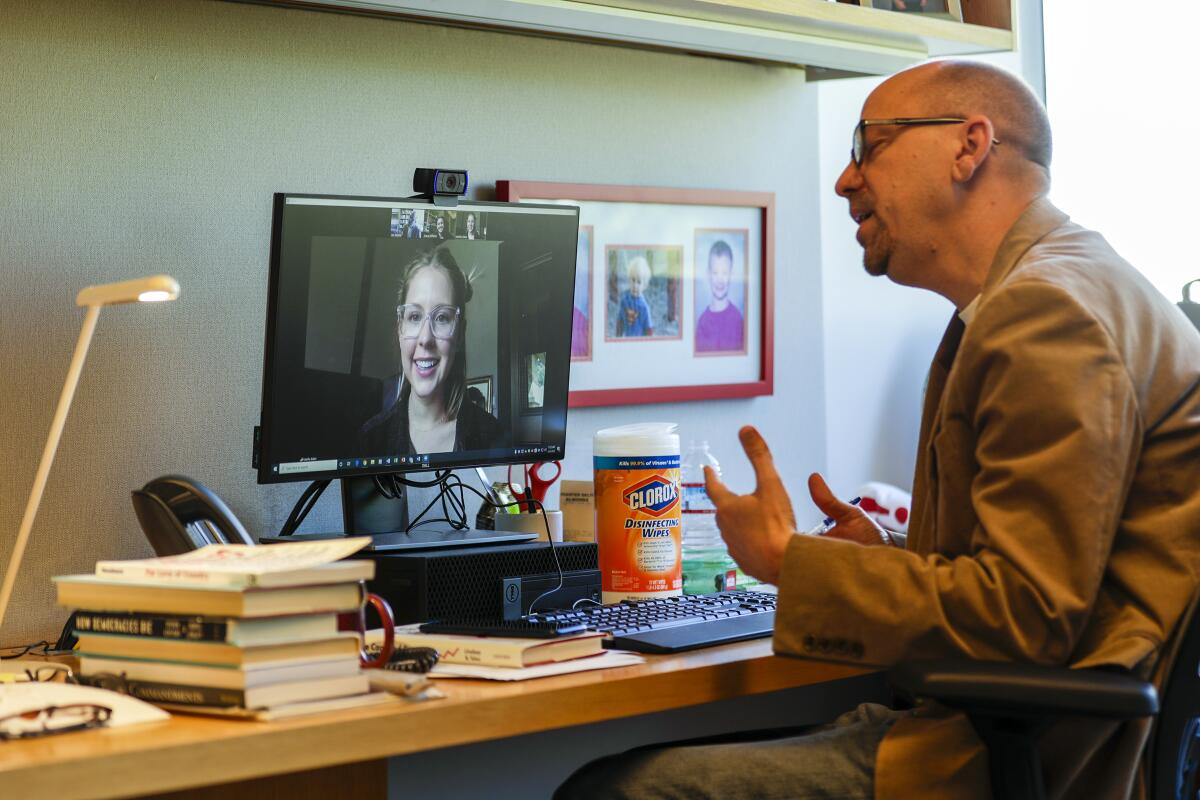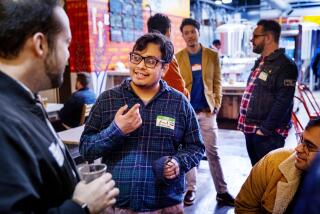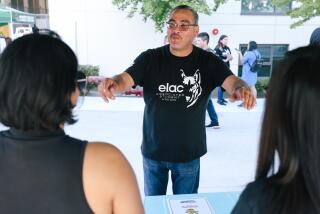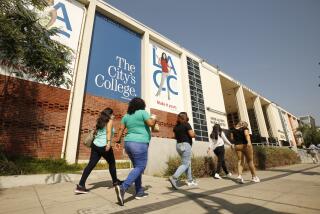How coronavirus could change college life: Outdoor classes, small group dorms, takeout dining

- Share via
It’s fall and here’s what college life could look like:
Students are back in class — but spaced apart in auditoriums, fitness centers, even outdoors. They’re eating cafeteria food again — but taking it to go rather than sitting with friends in dining halls. They’ve returned to campus housing — but are living in single rooms or a small group dorm, where if anyone gets infected with COVID-19, everyone would be assessed and possibly quarantined.
It’s not an ideal college experience. But most students are elated to return to campus after a spring term of isolation and staring at computer screens in online classes.
This back-to-school scenario, described by Claremont McKenna College, offers potential answers to the biggest question in higher education today: How will colleges reopen amid the coronavirus pandemic? Many colleges and universities across the nation, distressed by the negative financial, academic and social impact of continued online learning, are scrambling to find ways to safely educate and provide for their students in the fall.
Already, several universities, including Boston, Brown, Purdue and New York, have said they plan to reopen this fall or are leaning toward doing so. San Jose State, Cal State East Bay and UC San Diego have said they intend to offer a combination of in-person and online instruction. USC is exploring a later start for on-campus classes, retrofitting facilities for social distancing and hybrid courses with online and in-person activities.
UC President Janet Napolitano said this week that campuses will be required to satisfy systemwide guidelines to ensure public health and safety before being allowed to reopen. “Should there be a physical reopening of the campuses, it won’t be 100%,” she told the Bay Area Council. “It will probably be greatly reduced.”
Most universities are planning for multiple scenarios depending on public health assessments and their own campus needs — and all of them are different, experts said.
“Everyone has a different version of a scenario that seems like the most obvious one for them. It’s hard to find some consistency,” said Edward J. Maloney, who heads a Georgetown University center on teaching, learning and technology. “From most people’s perspective, back to normal is the goal. But even if you’re back to normal, it’s going to be a new normal.”
California K-12 schools also have started to examine how to reopen campuses, and Gov. Gavin Newsom said Wednesday that schools may be able to open as early as July. Each district will make its own decision, however. Local officials caution that health and safety measures are far from being in place and teacher unions said workplace changes are subject to bargaining.
Maloney and Joshua Kim, an online learning expert at Dartmouth College, recently laid out 15 fall scenarios that colleges are discussing. They include starting the fall term later, bringing students back in waves of smaller groups, using hybrid online and in-person instruction or redesigning courses into shorter blocks.
For Claremont McKenna and other small liberal arts colleges, the urgency to reopen campuses is particularly strong. Close-knit residential learning communities are their signature brand. Claremont McKenna educates 1,300 undergraduates, with average class sizes of 18. Nearly all students live on campus. And President Hiram Chodosh and faculty routinely invite them to their homes for dinner.

“We thrive on social density,” Chodosh said. “So the dispersion of a community that thrives on social density is not a sustainable value proposition for us.”
In a message to the campus community, Chodosh said the most likely scenario for fall would be a modified return to campus, provided that public health improves, stay-at-home restrictions relax and testing and contact tracing capabilities increase.
Claremont McKenna students who don’t want to return this fall can apply for deferment. International students who can’t get visas to return or those at greater risk, such as immuno-compromised students, can continue online classes.
But many students who are chafing at home, stuck in their childhood bedrooms far from friends and the independent lives they’ve built, say they can’t wait to return to campus.
Charlie Streator, a junior in history who has returned to his Connecticut home for spring term, said he misses the learning that happens outside the classroom. One of his best memories, he said, was “being very nerdy together” with his classmates and professor after class. He recalled a huge debate over the most important war in history — Streator argued for the Crimean War, his friend insisted on the Franco-Prussian War. The professor invited the group to his home the following Sunday for Easter dinner with his family.
“I was like literally at that moment, ‘Oh so this is why I go to a small liberal arts college,’ ” Streator said. “What fills our day now is like a Zoom class or doing our homework, but there’s nothing else because we’re just trapped in our house. For a lot of people, it’s been a super isolating time.”
Liam Brennan-Burke, a junior studying economics and international relations, misses the bonding with friends: The late night study sessions that build community through “joint suffering,” the ping pong games that balance that out.
Zach Fogel, a sophomore majoring in philosophy and public affairs, said many of his friends are planning to take time off from school if they can’t return to campus. Fogel quarterbacks for the Claremont-Mudd-Scripps football team and sings with a campus a cappella group.
“A huge part of our school experience is being together,” he said. “So whatever I’ve got to do to go back, I’ll do it. Whatever the restrictions are, I’ll follow them.”
The campus is a lifeline for Brooklyn Montgomery, a low-income, first-generation sophomore who experienced homelessness and hardship growing up with her single mother in Tucson. She said the college has given her a full scholarship, along with a secure place to live, a campus job and plenty to eat — and, she added, a top-notch program in government, her passion. The college has allowed her to stay in campus housing during the pandemic because she has nowhere safe to go.
“CMC has really taken care of me, “ she said. “I definitely want to be here in the fall.”
That widespread sentiment has sent Claremont McKenna staff into overdrive — often working 12-hour days, seven days a week since the pandemic intensified in mid-March — as they plan reopening scenarios. They are consulting healthcare professionals but mainly using their own expertise to prepare for myriad situations, including a worst case scenario of a second wave COVID-19 infection hitting simultaneously with flu season, sending everyone off campus again.
Sharon Basso, vice president of student affairs, and her staff have assembled an Excel document with nearly 25 tabs laying out myriad details. Basso stressed that the campus will take the lead from public health officials and incorporate protocols for testing, quarantines, contact tracing and social distancing.
To teach classes with enough physical distancing, the college is considering changing venues and scheduling. Dean of Students Dianna Graves said faculty may teach smaller classes in multiple sections, extending hours into the night. They may have half the class attend in person one day while the other half does so online, then flip the next day. They may move classes into larger spaces, including the auditorium and fitness center, and are considering buying more outdoor furniture to meet in open space during good weather.
To ensure safe living arrangements, Claremont McKenna has leased nearby apartments that could accommodate more than 100 additional students. Another idea is to group students in clusters, similar to a family unit, and limit their close contact with those on other floors.
Basso said officials are looking at installing hand sanitizer stations at the entrance of each residence hall and making health kits for each student with a thermometer, mask, gloves, Tylenol and Gatorade. They plan to continue tele-medical services, including mental health counseling. And they’re preparing for a range of dining options, including take-out meals only or eating in cafeterias but at a distance.
The level of detail extends to whether they should set higher water temperatures for washing machines and whether they should invest in ethernet cables and ports in case WiFi bandwidth is overwhelmed by a return to campus that still includes widespread online learning.
“These strategies may not work. They may not be feasible,” Chodosh cautioned. “But we need to exhaust the path before we get to that particular dead end.”
Similar planning is underway at Claremont McKenna’s four sister undergraduate institutions in the Claremont Colleges consortium. Pomona College President G. Gabrielle Starr said the campus is considering delaying the start of fall term or limiting students who return — possibly to freshmen or transfer students so they get the all-important on-campus experience. Students may take one or two courses online, then take subsequent ones on campus. Pomona also has secured additional leases for campus housing in case more spacing is needed.
Pitzer College President Melvin L. Oliver said he’s concerned that continued requirements for social distancing could compromise the experience of a liberal arts campus. But mindful of comparisons of a small campus to a “landlocked cruise ship,” he said he plans to make sure protocols are in place for testing, which may be required before students return, and contact tracing, possibly electronic. He also said some older faculty and staff who may be more vulnerable to infection may continue to work remotely from home.
The five undergraduate Claremont Colleges, which allow their students to take courses at any of their campuses, are aiming for a joint decision by June or July on a fall start date.
“Every time you peel the onion,” Oliver said, “there’s a level of complexity that’s difficult to untangle.”
More to Read
Sign up for Essential California
The most important California stories and recommendations in your inbox every morning.
You may occasionally receive promotional content from the Los Angeles Times.











